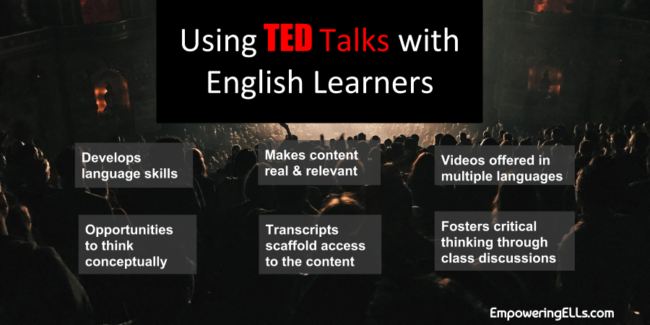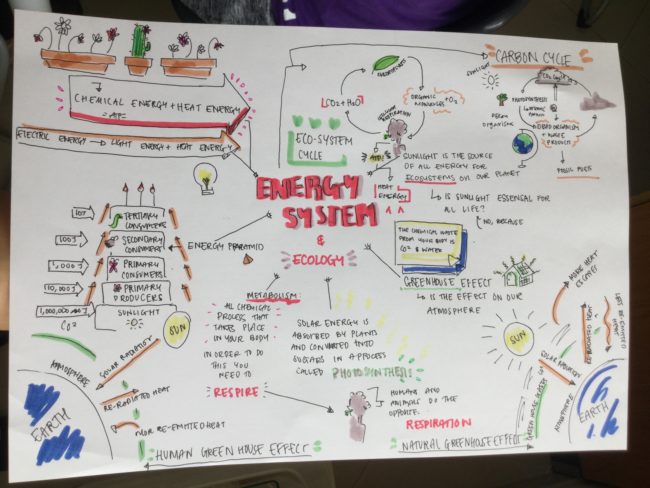TED Talks are not just for the high performers. They are filled with rich opportunities for ELs to develop their language skills, connect to content, and foster critical thinking skills.
Selecting Good TED Talks for MLs
On the TED website, you can choose from a range of different topics. Select a topic that your students would be interested in. Remember to keep in the mind the lexical difficulty of the presentation and the rate of speech of the speaker giving the talk.
Sometimes ELs can find foreign accents difficult to comprehend as well. So, if possible, find a speaker with a clear and natural accent. If you watch TED Talks on Youtube, you can have students turn on the caption in their home languages. Though the translated captions might not be 100% correct, it still helps ELs understand the video.
Another benefit of using TED.com is that you can do a custom search for the length of the video and topic genre. Depending on the length of your lesson, you can select from many shorter talks under 6 minutes or longer ones over 18 minutes. The shorter ones are ideal if you want to spend more time reviewing and doing more activities in class with the content.
Below are 3 good activities that you can try when viewing TED Talks in your English classroom. The exercises focus on improving students’ vocabulary, listening, note-taking abilities, discussion skills, and critical thinking skills.
1. Learning New Vocabulary
Most TED Talks have a transcript available to download for free via their website. This is extremely helpful for teaching difficult vocabulary that the speaker uses in their presentation.
- Before your lesson, you can download the script and briefly skim over the text to find words that your students could have difficulty understanding.
- Make a separate vocabulary list pulling those words from the text.
- Look for vocabulary words that are Tier 2 to teach academic vocabulary words that frequently appear across disciplines
A best-practice strategy would be creating a short list of concepts connected to the theme of the video. For example, if you were to teach Suzzane Barakat’s video entitled, “Islamophobia Killed My Brother”, key vocabulary words might include:
- Racism
- Bias
- Discrimination
- Prejudice
Teaching concept-based vocabulary leads to critically thinking because they help students form connections between different contexts. Students can now use these terms when talking about the big idea of the video, and conceptual terms can be used across contexts and events. Instead of talking about Islamaphobia, they can transfer the concept of discrimination to another event in history.
Using the list, you can pre-teach the words before watching the video. Plus, you can use the vocabulary list for other activities in class, such as additional previewing or reviewing of the content.
If the option is available for your TED Talk, give students the transcript in their home language. The translated transcript is more accurate than Youtube’s caption and still offers another way for ELs to access the same content as their classmates.
Another activity that works well with this method is to give the students small parts of the script to preview. Without deciphering meaning from the text, simply ask them to circle difficult words that they see in pairs. After a few minutes, ask them what they found. Then, review the words as a class before watching the video.
Note-taking and Listening Comprehension
TED Talks are also excellent tools for giving students more practice taking notes in class. Note taking integrates both writing and listening skills which can further enhance comprehension.
Pre-tasks and Modeling
When students are taking notes for the first time, it helps to guide them slowly. Model the note-taking task with examples of what to do before they have to do anything themselves. You can choose to model traditional forms of note-taking that we’re familiar with (bullet points, Cornell Notes). However, you can also consider modeling sketchnoting as it adds the visual element of synthesizing information.
To start, select a short TED Talk that most people in the class would find interesting. Determine the central theme or concept of that talk. Returning to Barakat’s video, the concepts might include community, advocacy, perception, media’s influence, etc. Then create a stimulating question connected to the central theme of the video such as, “How does media portray different religions?” Let students discuss the question to activate schemata
Next, tell them to simply observe you take notes on the board as the video plays. You may want to turn off the screen and only have the audio playing. The video can sometimes distract some students and interfere with listening comprehension.
For the first 30 to 60 seconds of the video, take brief notes on the board as you listen. The writing should be in point form and doesn’t necessarily have to be perfect grammatically. Typical notetaking uses abbreviations, symbols, acronyms, and concentrates on the key points of the speaker. Give a few examples of common abbreviations as you write.
Students can observe the notes that you take to get a better idea of what they should do. After your note-taking demonstration, pause the video. You can summarize the points that you made. Also, elicit some comments from the students as you go from point to point on the board.
By modeling the task in this way, they should be more confident with their own note-taking.
Students Try Taking Notes
To continue the activity, tell the class that it is their turn to take notes for the next segment. They can use their own notebooks, on lined paper, or blank A4 paper for sketchnoting.
Unpause the TED Talk. The students can then listen and practice note taking for about a minute.At the appropriate time, pause the video again. Ask a few individual students to explain some of the details that they heard. Encourage them to refer back to their notes.
On the board, write down the key points that the students say. Elicit more answers and help with difficulties when necessary. After asking several students, the board should be filled with lots of details from the video segment and should help solidify understanding. For those who are sketchnoting, ask to show their visual notes with the class as examples.
You can continue this process a few more times until the TED Talk is finished.
3. Student-Created Quizzes and Class Discussion
If you have time remaining in the lesson, you can put the students into small groups and have them create a mini quiz from the notes. This activity takes some creativity, but most students tend to enjoy it because of the competition with their classmates.
For extra guidance, tell them to create a few true/false questions, factual questions, and discussion-based questions. If they need more ideas, they could ask people to define vocabulary from the TED Talk transcript.
Give them a few minutes to create the mini quiz, then each group takes a turn asking the other groups the questions that they created. To keep it competitive, you could keep track of the correct answers on the board. The group with the most points at the end wins.
To foster deeper thinking around the concepts of the video, consider facilitating a student-led discussion using the Harkness Table. This is my go-to strategy when getting ELs to think critically. The Harkness Table reflects one of my main teaching principles: Teaching is more about facilitating learning experiences than delivering content. . With the Harkness Table, students work collaboratively to construct meaning rather than passively receiving facts from me.
To engage in a Harkness Table, students first generate questions that they have from watching the video. Then have students sit in a circle, offer one question at a time, and allow the class to contribute answers. This way students are constructing an understanding of the text, thinking critically about the answers, and evaluating the validity of each other’s ideas.
Key Benefits of Using These Activities
By integrating these types of activities into your lessons, students can improve their vocabulary, listening, note-taking, and discussion skills. Using authentic content from TED Talks will improve student motivation and increase engagement in class as well. Because of these advantages, it would be worthwhile to include TED Talks in your language classes more often to enrich students’ learning experience.
Recommended TED Talks for ESL Lessons
Shorter videos are ideal for most learning contexts. Here is a direct link to good TED Talks for ESL students under 6 minutes in length on the TED website. You can browse through the collection to find a video that matches your students’ preferences and language levels.
Do you have any other recommendations or ideas for using TED Talks in your English classes? Please write them below in the comments.
Paul Young (@ESLexpat) is an experienced language instructor and travel blogger currently based in South Korea. For more information about using TED Talks for the English classroom and other interactive ESL activities and games, visit his website ESLexpat.com.



